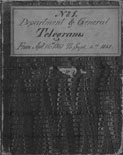Introduction
During the American Civil War (1861-1865), Indiana Governor Oliver P. Morton's staff recorded thousands of the governor's incoming and outgoing telegrams in small, bound books. The governor and his staff communicated by telegraph with the highest and most prominent government and military leaders in the North, including President Abraham Lincoln, Secretary of War Edwin M. Stanton, United States Senators and Representatives, other Northern state governors, and generals commanding in all the theaters of operations. As perhaps the most influential of the Northern state governors during the Civil War, Morton exerted significant influence over federal policies and military planning. A tireless worker for Union victory, he communicated his ideas, plans, news, and opinions by telegraph wires to other leaders to shape war policy. While most communication was incorporated into the books there were roughly 5000 separate slips that were not. This comprehensive collection of books and slips may be the best documentation of an important Northern governor during the Civil War to survive. The physical Civil War Governor Morton Telegraph books and slips are located at the Indiana State Archives building, who collaborated with IU Indianapolis University Library to make this digitization project possible.
Uses of the Telegraph Books
Researchers will find many uses of these messages. Historians studying politics and military planning at the highest levels of federal and state government during the Civil War will find many important communications. Persons studying the organization and actions of Indiana volunteer regiments and batteries will gain useful insights. Biographers, local historians, and genealogists will all learn much from consulting these records.
Arrangement
Morton's secretaries copied his outgoing and incoming messages in chronological order on opposite pages of the books, allowing them tofind corresponding messages quickly and easily. Messages to and from President Lincoln, cabinet secretaries, and Generals Grant, Halleck,Sherman, Rosecrans, Buell, and Burnside were often copied into volumes labeled "Department Telegrams," with the more local messages copiedinto "General Telegrams" books. However, in the rush of office business, often during great crises like Bragg's advance on Louisville and Cincinnati in 1862 or the Morgan Raid in 1863, messages that typically would appear in "Department" books were copied into "General"books, and vice versa.

This project is made possible by a grant from the U.S. Institute of Museum and Library Services.

